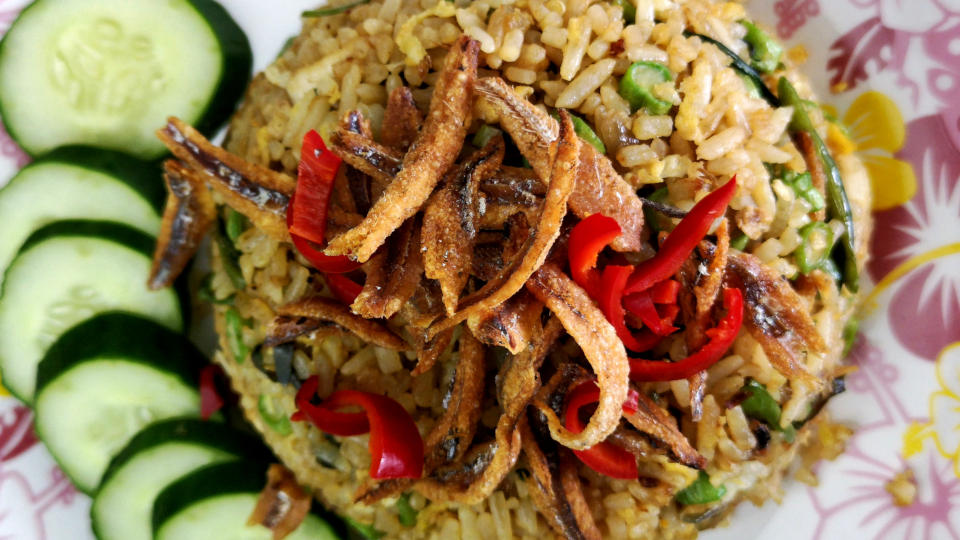During my time at a previous restaurant, I had the privilege of witnessing the enchanting process of preparing beef rendang. This dish quickly became one of our most beloved offerings, often served alongside fluffy nasi lemak, and it remained a permanent fixture on our menu.
Few dishes can elevate the senses quite like beef rendang. It is not merely a meal; it is a symphony of flavors that captivates the palate.
Today, I am excited to share the cherished recipe from our kitchen—one that may require a bit of effort but promises an unforgettable taste experience. Join me as we uncover the secrets to creating this exceptional dish!
Note: In 2011, CNN named rendang the most delicious food in the world.

The Main Ingredients Required to Prepare Beef Rendang
Beef rendang is a delectable dish that hails from West Sumatra, with our version influenced by Malaysian culinary traditions. Most Malaysian beef rendang recipes typically include the following ingredients:
- Beef: Sirloin is ideal, but topside, beef chuck, or any tougher cuts work well since the meat is stewed for several hours.
- Coconut Cream: Freshly pressed coconut cream is best; if unavailable, canned or tetra-packed options are acceptable. Ensure you select coconut cream meant for cooking, as it is often confused with coconut milk.
- Candlenuts: These nuts help thicken the gravy. If unavailable, macadamia nuts can be used as a substitute.
- Onion, Ginger, Galangal, Turmeric: These ingredients form the essential flavor base for rendang. Onions provide the body of the gravy, while galangal adds a unique flavor. If fresh turmeric is hard to find, turmeric powder can be used instead.
- Cardamom Pods, Cumin Seeds: Common spices found in many countries.
- Chili: I prefer local red chili (Serrano). For a milder rendang, remove the seeds and pith before use.
- Lemongrass: Use only the pale yellow bulbous bottom part. Bash it before use to release its flavor.
- Assam Keping: This sour ingredient is available in dry pieces. Tamarind pulp can be used as a substitute.
- Sugar: To balance the sourness, add some sugar; palm sugar is preferred, but regular or brown sugar will do.
- Turmeric Leaves, Kaffir Lime Leaves: These leaves enhance the flavor of the rendang.

Steps to Cook Beef Rendang
- Cut the beef into 4 cm cubes. Avoid cutting it too small, as it may break apart during cooking. Ensure you cut against the grain with a sharp knife.
- For the spice blend, chop all larger items. Blend without adding water, as the chilies and onions provide enough moisture.
- Heat vegetable oil in a wok. Sauté the spice paste over low to medium heat until aromatic, stirring constantly to prevent scorching.
- Add the beef and mix thoroughly with the spices.
- Add coconut cream and some hot water to the wok.
- Prepare the lemongrass by bashing it to release its flavor. Add the lemongrass, kaffir lime leaves, asam keping, and turmeric leaves.
- Once the liquid boils, reduce the heat and simmer. Add water as needed if the stew starts to dry out.
- Continue cooking until the beef is tender and dark brown, approximately three hours.
- Since this is a dry rendang, continue cooking until the liquid is fully evaporated, allowing the beef to caramelize in the remaining oil.
- Garnish with thin strips of turmeric leaves, red chilies, and kaffir lime leaves.

More Tips to Make the Best Beef Rendang
- Using a wok is preferred, but a pan with a curved bottom will also work.
- Adjust the amount of chili based on your heat preference.
- Store opened coconut milk in the refrigerator or freeze it in portions for longer shelf life.
- If fresh spices are unavailable, ground powders can be used as substitutes.
- Bashing lemongrass before adding it helps release its aromatic flavor.
- Some recipes may include star anise and cinnamon for added flavor.
- Asam Keping can be omitted or replaced with tamarind paste if necessary.
- Turmeric leaves can be substituted with more kaffir lime leaves if unavailable.
- Stir frequently towards the end of cooking to prevent sticking and burning.
- Rendang tastes even better the next day after the spices have fully penetrated the beef.
Other Rendang Recipes for You
There are two main types of beef rendang based on water content:
- Dried Beef Rendang: This traditional version is slow-cooked until the coconut milk evaporates, resulting in a thick sauce. It can be stored at room temperature for several weeks or frozen for up to six months.
- Moist Beef Rendang (Kalio): This version is cooked for a shorter time, resulting in a thicker gravy. It is popular in Malaysia, Singapore, and Brunei.
What to Serve with Rendang
Beef rendang is best enjoyed with steamed rice and condiments like fried onions and chili. It is also a popular dish during major festivals in Malaysia.
Other Recipes You Might Enjoy
If you love this authentic beef rendang recipe, consider trying these other popular Asian dishes:
- Chicken Rendang: A delicious alternative for those who prefer chicken.
- Chicken Varuval: An intense and flavorful Indian dish popular in Malaysia.
- Mee Goreng: A beloved street food with Indian Muslim origins.
- Wonton Soup and Noodles: Our unique take on wonton noodles, distinct from the Hong Kong version.





